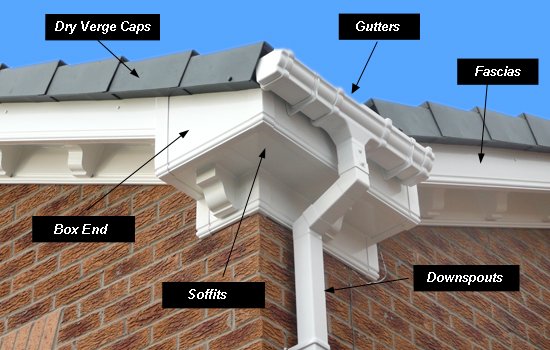
If you have done construction before, you understand that there are two components to the outside of your home, the place where your outer walls meet your roof, referred to as fascias and soffits. These are referred to with other names, yet they serve the same purpose, regardless of what they are referred to or how they are built. This is typically where the gutter of the house can be found attached, preventing the water from simply dripping down onto the ground beneath. There are some basic ideas to consider if you are building a home regarding fascias and soffits, and also ways to repair or maintain them once your home is complete.
What Are Fascias?
Standing outside of your home, looking up at where the top portion of the outer wall meets the roof, there is a point where they come together. This is sometimes referred to as a roof line, which makes sense, in that it forms a line where the roof and the outer wall come together. There is always going to be overhang from the shingles, typically dropping into a gutter, and the gutter is attached to the outer fascia. It is simply a very long street board, one that runs across the edge of the lower roof, fixed directly to what are called roof trusses that provide the supporting structure of the roof itself. This is how they are able to remain secure for so long, and can also support not only the weight of the gutter, but also the water that comes into the gutter during the rainy season. It is important to have this board a fixed at all locations into each of the roof trusses, to ensure that it can handle the rain.
What Are Soffits?
This is simply a board that is beneath the fascia board. It’s what people can typically see when they are standing below. It is often ventilated, allowing air to flow up into where the roof is, preventing mold and mildew from actually forming. There can be alternate forms of insulation such as ventilating the fascia board, but this can lead to significant problems. If there is no gutter installed, the water will simply seep inside, leading to dry rot and mold forming very quickly. This can also cause a significant amount of decay on the part of the internal structure of the wall, as the water will simply flow from the fascia and soffits into the plywood, and presumably further into the insulation and sheet rock inside. Therefore, it is always good to have underside ventilation only on the soffits, especially if you have not had time to put your gutter system up into place.
Many Different Types Of Fascias
There are actually a couple different types of fascia boards that are available, in various sizes, styles and colors. It just depends on the color of your home, and what type of effect you are looking for, and how much money you have to spend. They can be as thick as 25 millimeters, and if so, you may not need to add the soffit or backing board. You will then simply affects your gutter directly to the fascia, connecting the fascia and soffit joints together. It is recommended that you use stainless steel fixings when you are doing this project just to make sure that rust cannot occur. This is standard for most projects that are made today, but people will often use cheaper materials which can lead to future problems. The different types of fascias include contemporary, heritage, and many others that must follow building regulations and code. As long as you fall within those parameters, it’s actually very easy to create a unique our appearance where your upper wall comes to meet your roof.
There are many other components to a roof that should be considered when you are finishing your home including the type of gutter that you are installing, the type of flashing that you are using which can be either made of metal or rubber. This is what goes around chimneys and pipes, preventing water leaks, and of course the type of shingles that you will use for roofing material. However, it is the fascias and soffits that play a very important role, not just a place where the roof and outer wall bisect. It is important to always use the best materials, and also have the best ventilation possible, when installing these components on the exterior of your home.
